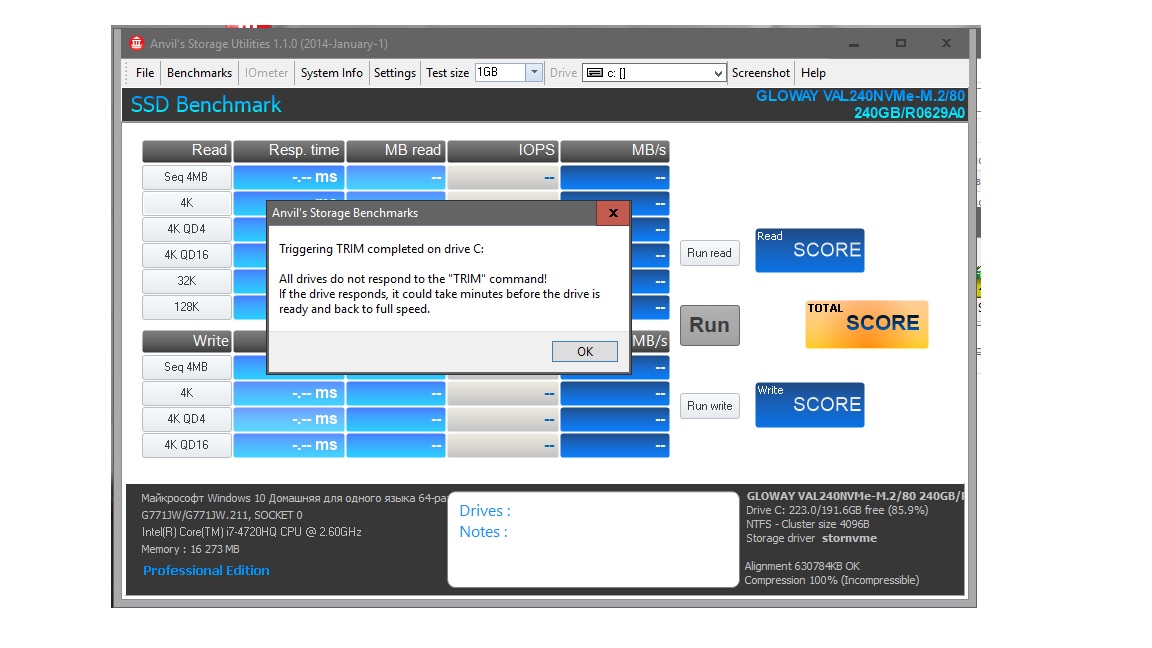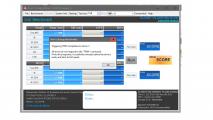Hi, i have prodlem with BSOD on my laptop. I have flashed BIOS with DXE module 4 for my system support NVME and installed clean Win 8.1, but after i found what problem, BSOD freeze my laptop without creating memory dump. I have reinstalled official WIn 10 but have same problem. Memory dump was created after manual system shut down, but during BSOD before no. Open fabric 1.5 non digital signed driver causes windows recover after reboot. Could u advice me any solution? Looks like problem in drivers. My system - ASUS ROG G771JW i7-4720HQ, HM 87, 16 Gb, GTX960M, 1 Tb Toshiba HDD, Gloway M2 NVME SSD 240 Gb. SSD doesn’t count Power on Hours only Power on Count, and i am not shure about temperature, it is always shows - 46c.
Driver - 10.0.17763.1
SCSI\DiskNVMe____GLOWAY_VAL240NVM29A0
SCSI\DiskNVMe____GLOWAY_VAL240NVM
SCSI\DiskNVMe____
SCSI\NVMe____GLOWAY_VAL240NVM2
NVMe____GLOWAY_VAL240NVM2
GenDisk
Controller
PCI\VEN_126F&DEV_2263&REV_03
PCI\VEN_126F&DEV_2263
PCI\VEN_126F&CC_010802
PCI\VEN_126F&CC_0108
PCI\VEN_126F
PCI\CC_010802&DT_0
PCI\CC_010802
PCI\CC_0108&DT_0
PCI\CC_0108
@Fernando can you advise best driver for him to try, thanks! He has no BSOD with regular HDD, only when using the SSD, so assumed it’s a driver issue.
Today I tried to check trim function, it doesn’t work, temperature sensor not read information.
@Toorist :
Questions:
1. Which BSOD error message did you get?
2. Is the NVMe SSD your bootable system drive or just a disk drive for storage purposes?
3. Why are you using Win8.1 instead of Win10, which natively has a much better NVMe support?
4. Why did you install an unsigned OFA driver? Note: A mod+signed variant of the OFA NVMe driver v1.5.0.0 is availabe within this Forum.
By the way: The only relevant HardwareIDs are the ones of the NVMe Controller (listed within the “Storage Controllers” section of the Device Manager).
EDIT:
Which OFA NVMe driver did you install? Only the the OFA driver v1.5.1200 doesn’t support TRIM, because it has been designed for Windows Server 2003.
1 SYSTEM_SERVICE_EXCEPTION
2 yes ssd bootable
3 i use win 10
4 i use win driver, OFA driver didn’t work properly
5 i tried to use OFA 1.5 rev. 157 for win 10
@Toorist :
If you are running Win10 and using the MS in-box NVMe driver, you shouldn’t get an NVMe driver related BSOD.
Since you obviously had upgraded the OS from Win8.1 to Win10 and tried several NVMe drivers, I recommend to do a clean install of Win10 in UEFI mode onto your NVMe SSD. Don’t forget to remove or unplug all other disk drives before you begin with the OS install.
This OFA NVMe driver definitively supports TRIM (like the MS Win10 in-box NVMe driver).
Windows was installed clean without any other drives connected. OFA NVMe driver makes windows unbootable, i have to do recovery. I have 1 BSOD per day, looks like SSD stops to work because it just freeze 0% data collected in memory dump.
Querying C:\ disk space and sector size information…
C:\ has 512 bytes per sector, and 8 sectors per cluster.
50224281 out of 58449919 clusters are free.
Generating random target data block (16384 bytes)…
First 16 bytes: 29 26 6C C6 FE 14 11 C6 9A ED E5 16 6F 3F 30 88…
Creating C:\trimcheck.bin…
Querying file final paths…
DOS : \?\C:\trimcheck.bin
GUID : \?\Volume{aa6ef4c8-4dec-4f16-802e-d2b18de94ee9}\trimcheck.bin
NT : \Device\HarddiskVolume4\trimcheck.bin
NONE : \trimcheck.bin
Writing padding (33554432 bytes)…
Writing data (16384 bytes)…
Writing padding (33554432 bytes)…
Flushing file…
Checking file size…
Data is located at Virtual Cluster Numbers 8192-8195 within file.
Querying file physical location…
trimcheck.bin has 9 extents:
Extent 0: Virtual clusters 0-255 are located at LCN 2192864
Extent 1: Virtual clusters 256-767 are located at LCN 3120028
Extent 2: Virtual clusters 768-3527 are located at LCN 6968284
Extent 3: Virtual clusters 3528-5639 are located at LCN 6988052
Extent 4: Virtual clusters 5640-9925 are located at LCN 8464694
(this is the extent containing our data)
Extent 5: Virtual clusters 9926-12997 are located at LCN 2294355
Extent 6: Virtual clusters 12998-15041 are located at LCN 1174120
Extent 7: Virtual clusters 15042-16145 are located at LCN 4547776
Extent 8: Virtual clusters 16146-20239 are located at LCN 8427016
Closing file.
Saving continuation data to C:\trimcheck-cont.json…
Flushing buffers on \.\C:…
Opening \.\C:…
Flushing buffers…
Deleting file…
Flushing buffers on \.\C:…
Opening \.\C:…
Flushing buffers…
Test file created and deleted, and continuation data saved.
Do what needs to be done to activate the SSD’s TRIM functionality,
and run this program again.
Usually, you just need to wait a bit (around 20 seconds).
Sometimes, a reboot is necessary.
Press Enter to exit…
C:>fsutil behavior query disabledeletenotify
NTFS DisableDeleteNotify = 1 (Включено)
ReFS DisableDeleteNotify = 0 (Отключено)

Which Windows version did you install?
Who gave you the advice to install a not even digitally signed NVMe driver?

This screenshot indicates, that it is the in-box NVMe Controller of your SSD, which doesn’t let the TRIM command pass into the data storage cells of the SSD.
I deside to try it because i haven’t alternative. Does it mean that problem in driver for controller not in ssd?
http://www.gloway.com.cn/Product/SSD/27_27.html - this is my ssd
I have installed last wersion of Windows from official site and completely update it. Ver 1809 Rev 17763.292
The NVMe Controller chip is within the SSD and not on-board of your mainboard.
sadness
Maybe faulty SSD? Can you RMA?
what is it?
Look >here<.
i thouught about it, but i think it’s impossible. I bought ssd through middleman. No way to sent it back.
Trim didn’t work even with OFA driver, I have checked it. It is defective ssd or incompatibility with my system of this ssd.
@Toorist :
If the NVMe Controller of your SSD doesn’t let the TRIM commands pass through into the storage region of the SSD, the TRIM checking will always fail, not matter which NVMe driver you are using.
GC will still work if TRIM does not, so it should be OK. You can try RMA anyway, sometimes RMA only requires serial # or other info off the device, if you don’t try you’ll never know.
I want to check it on another motherboard first.